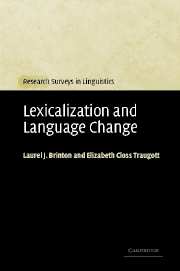Book contents
- Frontmatter
- Contents
- List of figures
- List of tables
- Preface
- List of abbreviations
- 1 Theoretical contexts for the study of lexicalization and grammaticalization
- 2 Lexicalization: definitions and viewpoints
- 3 Views on the relation of lexicalization to grammaticalization
- 4 Toward an integrated approach to lexicalization and grammaticalization
- 5 Case studies
- 6 Conclusion and research questions
- References
- Index of names
- Index of subjects
- Index of words and forms
4 - Toward an integrated approach to lexicalization and grammaticalization
Published online by Cambridge University Press: 03 February 2010
- Frontmatter
- Contents
- List of figures
- List of tables
- Preface
- List of abbreviations
- 1 Theoretical contexts for the study of lexicalization and grammaticalization
- 2 Lexicalization: definitions and viewpoints
- 3 Views on the relation of lexicalization to grammaticalization
- 4 Toward an integrated approach to lexicalization and grammaticalization
- 5 Case studies
- 6 Conclusion and research questions
- References
- Index of names
- Index of subjects
- Index of words and forms
Summary
Introduction
The previous chapters have set out a number of definitions of lexicalization and a number of ways in which lexicalization has been construed in relation to grammaticalization. Many of these definitions and views have been contradictory. This chapter will attempt to reconcile some of the differences and present a coherent view of lexicalization viewed as change in form, internal structure, and meaning.
We have seen that in its broadest sense “lexicalization” as a historical phenomenon has been conceptualized in the literature as “institutionalized adoption into the lexicon,” or the creation of neologisms. In this view “lexicon” is understood as an inventory of both “lexical” and “grammatical” units (see 1.2.2). Adoption may be from the lexicon, from morphology, or from syntax (yielding partially new forms); it may even be adoption from another language (borrowing) or invention that yields completely new forms (coinages). Therefore, all changes in the inventory of forms in a language – both those that are prototypically seen as lexicalization and those that are prototypically seen as grammaticalization – fall under the rubric of “adoption into the lexicon”, i.e., lexicalization. Forms resulting from routine processes of word formation, including blends such as telemarketing (< telephone + marketing), derivations such as biodegradable, compounds such as cable television, conversions such as text (V) < text (N), fixed phrases such as get it together, clippings such as disco (< discotheque), acronyms such as yuppie (< young urban professional), deliberate coinages such as xerox, or back formations such as baby-sit (< baby-sitter), all represent additions to the inventory of forms in the language.
- Type
- Chapter
- Information
- Lexicalization and Language Change , pp. 89 - 110Publisher: Cambridge University PressPrint publication year: 2005



